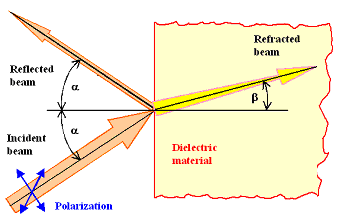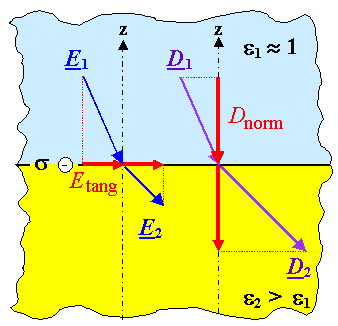 |
The task:
Calculate and understand intensities, angles, phases, polarization
and attenuation (damping) of the various light beams shown from the materials properties |
|
|
|
 |
Still assuming a perfectly flat surface |
|
 |
First step: Decompose impinging light into two waves with polarization in he interface
plane (TE case) or at right angles (TM case) | |
|
 |
Energy conservation yields for the intensities: |
|
|
|
| |
|
| |
| |
 |
Boundary conditions as shown in the figure involve the "dielectric constant
e and thus the so far only relevant material property. |
|
|
|
 |
Considering energy (proportional to E2) and momentum (proportional
to k2") conservation for the TE and TM case separately yields the Fresnel equations
that provide the answers to the questions above | |
| |
 |
A wealth of insights and relations follow, e.g. or field strength E or intensities
I: | |
| | |
Eref
Ein |
| = – |
n – 1
n + 1 |
| | | |
| | |
Iref
Iin | |
| = |
æ
ç
è |
n – 1
n + 1 |
ö
÷
ø |
2 |
|
| |
| |
 |
one consequence as example for the power of these equations: n = 2 means that
almost 10 % of the intensity will be reflected, implying that for optical instruments you must
provide some "anti-reflection" coating. | |
| | |
| |
 |
Using the complex (and frequency dependent "dielectric constant e(o) = e' + ie''
yields the complex index of refraction | |
| n2 | = |
1
2 |
æ
ç
è |
æ
è |
e' 2 + e'' 2 |
ö
ø |
½ |
+ e' |
ö
÷
ø |
| k2 | = |
1
2 |
æ
ç
è |
æ
è |
e' 2 + e'' 2 |
ö
ø |
½ |
– e' |
ö
÷
ø |
|
|
| |
| |
|
 |
The imaginary part k describes the attenuation (damping)
of the transmitted wave in the material. | |
| | |
| |
 |
Not so perfect materials and properties like specular and diffuse Reflection,
transparency, Translucency, Opacity. | |
|
|
 |
Light is scattered at small things in all directions and the scattering of light
is the major topic encountered if we look at not-so-perfect materials |
|
|
 |
The picture illustrates:
Specular and diffuse reflection at the surface.
Scattering
of the transmitted light (running in different directions) at defects or imperfections contained in the material (fat droplets
in milk, air bubbles in glass, ...).
Specular and diffuse reflection at the internal surface the light is coming out
off. This is described by a (different) polar diagram characterizing this surface. |
|
 |
Scatter mechanism depend on the size lsca of the scatterer"
relative to the wavelength:
lsca << l: The extreme case would be scattering at single atoms
or molecules. Proper nanoparticles also belong into this group. This
kind of scattering is called Rayleigh
scattering
lsca >>l: No problem, we covered that already. Just look at any
part of the sample by itself.
lmat »
l: Now we have a problem. What will happen in this case is difficult to deal with and no
general rules apply. This kind of scattering is called Mie
scattering | |
| | |
| |
|
© H. Föll (Advanced Materials B, part 1 - script)

